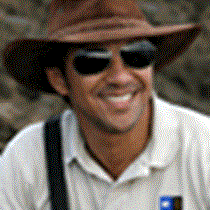Southern Isabela Island
It is hard to believe that already five days have gone since the Islander started operations here in the Galápagos Islands. Our itinerary is great, and today has proved to be even more than that. Right after breakfast, an eagerly group of sixteen guests accompanied by two naturalists headed to the summit of one of the largest active calderas in the world, Sierra Negra Volcano. None of us could expect to see what we saw on that walk. It is a brand new place for most of us and an incredible opportunity to explore new locations in the Galápagos.
Located in the southern portion of Isabela, Sierra Negra Volcano is above Cerro Azul Volcano. It is also considered to be the oldest and largest volcano on Isabela, with its caldera measuring about five miles by six miles across.
Our exploration began at Puerto Villamil, a small but charming village located at the southern most part of Isabela, where pick up trucks took us to Santo Thomas, the farthest point where you can go with the so called “local cabs.” We started the walk that took us through different zones of vegetation, giving us the opportunity to see the green and lush side of the island. Some of us had a great view of the rare woodpecker finch, known to be the only land bird in the Galápagos to use a tool (a small stick or branch) for foraging. After two hours of walking through some mist and mud we reached the caldera. What an impressive view! Unfortunately, part of it was covered with the mist and only part of the caldera was revealed to us when the sun shined occasionally at it. After a short rest, we started our walk again, this time heading to our designated picnic area.
After a light lunch, we started our way to “volcan chico”- a series of crater and fumaroles (columns of volcanic steam and gas) rising into the air. To get there, we had to cross a rather impressive lava field formed in 1979’s volcanic eruption, sparkled with some giant tree-like cactus. By the end of our walk over the lava field we were rewarded by an incredible panoramic view of Isabela, including the Perry Isthmus and the east/west coast lines.
Having successfully reached our goal, we returned to pick up our cabs to go back to town. Our adventure at Isabela did not end there, thought. The giant tortoises programs to preserve these species in Isabela were worth to pay a visit. A visitor center had been created in town for this purpose. By the end of a full day, we headed back to the ship leaving behind one of the most interesting places in Galápagoss: Isabela Island and its mysterious volcanoes.
It is hard to believe that already five days have gone since the Islander started operations here in the Galápagos Islands. Our itinerary is great, and today has proved to be even more than that. Right after breakfast, an eagerly group of sixteen guests accompanied by two naturalists headed to the summit of one of the largest active calderas in the world, Sierra Negra Volcano. None of us could expect to see what we saw on that walk. It is a brand new place for most of us and an incredible opportunity to explore new locations in the Galápagos.
Located in the southern portion of Isabela, Sierra Negra Volcano is above Cerro Azul Volcano. It is also considered to be the oldest and largest volcano on Isabela, with its caldera measuring about five miles by six miles across.
Our exploration began at Puerto Villamil, a small but charming village located at the southern most part of Isabela, where pick up trucks took us to Santo Thomas, the farthest point where you can go with the so called “local cabs.” We started the walk that took us through different zones of vegetation, giving us the opportunity to see the green and lush side of the island. Some of us had a great view of the rare woodpecker finch, known to be the only land bird in the Galápagos to use a tool (a small stick or branch) for foraging. After two hours of walking through some mist and mud we reached the caldera. What an impressive view! Unfortunately, part of it was covered with the mist and only part of the caldera was revealed to us when the sun shined occasionally at it. After a short rest, we started our walk again, this time heading to our designated picnic area.
After a light lunch, we started our way to “volcan chico”- a series of crater and fumaroles (columns of volcanic steam and gas) rising into the air. To get there, we had to cross a rather impressive lava field formed in 1979’s volcanic eruption, sparkled with some giant tree-like cactus. By the end of our walk over the lava field we were rewarded by an incredible panoramic view of Isabela, including the Perry Isthmus and the east/west coast lines.
Having successfully reached our goal, we returned to pick up our cabs to go back to town. Our adventure at Isabela did not end there, thought. The giant tortoises programs to preserve these species in Isabela were worth to pay a visit. A visitor center had been created in town for this purpose. By the end of a full day, we headed back to the ship leaving behind one of the most interesting places in Galápagoss: Isabela Island and its mysterious volcanoes.




